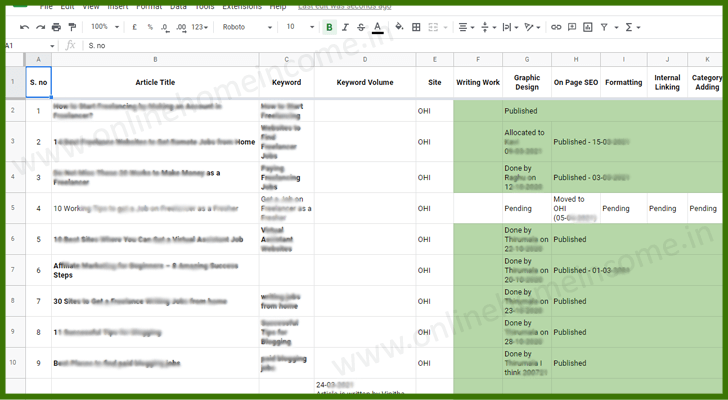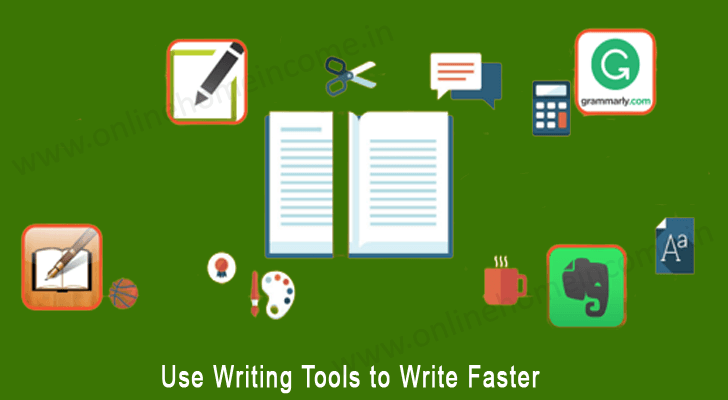Writing quality blog posts takes time. But however, these 8 tips from my experience help you write blog posts faster. You can save time for writing articles and put focus on other blogging activities.
In the blogger’s journey, one of the difficult processes is writing blog posts faster. The process includes researching to drafting, and editing.
However, with a strategic approach, you can speed up blog writing while still creating informative and engaging blog posts.
If you are a beginner or a pro-blogger, it is necessary to improve your blog writing efficiency.
On average, an experienced blogger can write a 2000-word article in about 4 to 5 hours.
This activity includes keyword research, content outline, writing the first draft, and performing on-page SEO.

In my early stages of blogging, writing blogs faster makes me feel overwhelmed and frustrated.
But over time, I learned the ways to write faster without compromising the content quality.
In this blog post, I will share proven tips that I personally use to write blogs in less time. Doing so helped me stay focused on other important blogging tasks.
I will cover everything from planning and structuring the post, writing the draft, and optimizing it for SEO.
Are you ready to travel with me and learn the strategies that I personally implemented to speed up blog writing?
Let’s get started.
8 Tips to Write Blog Posts Faster
Writing engaging long blog posts in a few hours requires a combination of thoughtful planning and creativity.
I am a full-time blogger, and my 13+ years of experience have helped me speed up blog writing.
First, start by finding a topic (that solves a real problem of your target audience). This step helps you build trust and authority (EEAT).
Then, do your own research to discover the content ideas and top-performing blog posts.
It helps you prepare a structure that improves your blog writing efficiency. Finally, start creating the first draft and optimize it for clarity.
When I sit down to write a blog post, I dedicate an hour to complete the first draft. Then, after a small break, I will read the post to remove repeated and irrelevant content (or messages).
At last, I will optimize the blog post for Search Engines. Also, I will add some screenshots, infographics, or short videos to support the statement.
With the right workflow, you can write blog posts faster and consistently publish them.
Let me share the eight actionable tips that I am implementing regularly to write blogs faster and more efficiently.
1. Create a Content Calendar

The best way to write blog posts faster, according to me, is by planning the content ahead. Yes, I prepare a content calendar for all future blog posts of my own blogs as well as client blogs.
A clear and structured content calendar brings clarity, improves consistency, and boosts my blog writing efficiency. Most importantly, I save plenty of time wasted in the research process.
So, let me tell you how to prepare a content calendar.
Step 1: Create a list of your blogging goals and plan when to publish your blogs. I always suggest publishing one high-quality post every week.
Step 2: You cannot get new blog post ideas when you sit down at a particular time. Therefore, brainstorm ideas in advance, like when you are browsing the Internet.
Step 3: Always maintain a Google Sheets to manage your content calendar. Keep it open whenever you actively browse online.
What are the elements of the content calendar?
- Blog post topics and tentative date to publish.
- Blog name where to publish the post.
- Draft deadlines.
- Source of the information.
- Assigned team members (writing first draft, grammar, proofreading, graphic designing, etc.)
Always tend to create a habit to avoid burnout. Maintaining a content calendar makes it easier to write a blog post quickly with confidence and structure.
The content calendar should include the topics you plan to cover, the dates to publish, and other details related to the content.
2. Prepare an Article Outline First
If you want to write blogs faster with clarity, you must have a clear article outline.
Having one saves you time, keeps you on track, and ensures your blog post flows smoothly. When I begin to write a blog post, I always prepare a detailed post outline.
This blog post outline includes the main topic, structure, supporting points, stats, data, and sources of reference.
I used to name it as a Content Instruction Document, which has all the data.
Here’s how to prepare an article outline for your next blog writing;
Pick the Main Topic
The first step is to identify the main topic of the blog post. It is the main theme or idea that you want to explore in the blog post. Ensure to include the primary keyword (or focus keyword) in the main topic – a small SEO nugget.
Brainstorm Ideas
Once you have identified the main topic, you can then brainstorm ideas about what you would like to include in the article. Prepare a list of ideas, and narrow it down to the most important points.
Outline the Structure
Now it’s time to create an outline and structure the blog post. Start by creating an introduction and include all other parts of the blog as stated in the article outline.
Finally, write your conclusion and make your readers take some action. Within each section, add more details, such as subheadings, quotes, and other relevant information.
When you have a clear outline, you can write a blog post fast and also ensure the message is clear.
3. Collect Materials, Info, Data, and Statistics
When writing a blog post, it is important to collect a variety of materials and reference URLs to help support your argument or topic.
Before diving into research, it is necessary to develop a research plan. It should include,
- The topic of the blog
- The target audience
- The purpose of the blog
- Any specific information you need to include
- A timeline for when the blog should be completed.
Research the topic to gain an understanding of the subject and to find any relevant information.
It includes articles, research studies, surveys, statistics, quotes, and other materials used to back up the post.
Collecting materials and reference URLs ahead of time can also help speed up the writing process and make the blog post more effective.
It is helpful to use a combination of sources, such as news articles, academic journals, reports from industry experts, and other reliable sources.
Additionally, having a materials list ready can make it easier to cite sources, which is mandatory for any blog post. Having the sources available can save time when you do formatting citations.
It can also make it easier to double-check the accuracy of the information in the post. At the same time, it will help you stay focused and on task.
4. Start Writing the Whole Content
After collecting all the materials and data, you can start writing the whole piece of content. Already, you have the article outline, which helps you in the current activity.
Writing the content for a blog post is a vital step in the blogging process. It allows bloggers to capture their ideas and get them down on paper. It gives bloggers the ability to create cohesive and well-structured posts.
The best way to ensure that a blog post is complete and of high quality is not to edit part of it before you finish the first draft.
Editing before the first draft is complete can be a waste of time. It can also lead to bloggers not being able to express themselves fully. Before bloggers start editing, they need to have a solid first draft.
It makes your content more accurate, and you can thoroughly explain the whole idea.
The first draft is likely to be more focused on getting the content ideas.
When bloggers have a first draft, they can go back and refine their content, make any necessary changes, or edit and make it more concise or detailed.
They can also add any additional information not included in the first draft. It ensures that the content is as perfect as possible before it is going to published.
By insisting that bloggers complete a full draft before editing, they will be able to ensure that they have fully expressed their thoughts and that their content is accurate and complete.
5. Make Use of Online Tools

Online tools can be very beneficial for writing blog posts faster by providing various features, such as spell-checking, grammar-checking, and automated formatting.
They can help to quickly correct any typos or errors in the content. As well as to ensure that the post is properly written and in the correct format.
Additionally, some online tools can provide helpful suggestions for improving the content. It includes adding secondary keywords or phrases to make the post more search engine-friendly.
Some of the writing tools I use for my blogging are listed below;
— Grammarly is a powerful and popular online writing tool that can help you produce quality content. It automatically detects spelling errors, fixes grammar mistakes, and provides suggestions and corrections.
— Google Docs is a great tool for writing blog posts. It allows you to easily create, edit, and share documents with others.
— The Hemingway app tool helps bloggers to break down harder sentences into shorter ones and makes them easy to read.
— The DupliChecker tool helps you check duplicate content. You should avoid duplicate content, as it is a critical SEO issue.
— Yoast SEO tool helps you optimize your blog post to rank higher on Google and get more recurring traffic.
Do not forget to check other tools like social media management tools, AD management tools, and other online marketing tools.
With the right tools, you can write better blog posts faster, allowing you to focus on other aspects of the blog.
6. Edit Your Draft and Produce Great Content
Editing the draft is one of the crucial steps to producing great content for your blog.
Editing your content not only ensures that you have a high-quality blog post that is free from errors and typos, but it also helps you become a better writer and increase your productivity.
When editing your blog post,
— The first step is to read it thoroughly for any grammar and spelling mistakes.
Check for any typos and correct them. Bloggers may also want to check for any inconsistencies in the content and fix them as well.
— The second step is to look for any part of the content improvement.
You may also want to look for any areas that need to be more concise or that you can use more detail.
— The third step is to review the structure of the post.
Look for any areas that could be made more organized or that need to be reworked. It may include reorganizing the post into smaller sections or adding more subheadings.
— The fourth step is to review the content of the blog post.
Make sure that the content is providing value to the reader and that it is engaging and informative. Once you are done, you should re-read the blog post and make sure that it is of high quality.
By following these steps, bloggers can easily edit their drafts and produce content for writing blog posts faster.
7. Write Headlines and Add Images as a Last Step
Writing headlines and adding images as a last step is a strategy that can help streamline the process of writing blog posts faster.
This approach allows you to focus on the content of the blog posts first and then add the headlines and images later.
When you write the content first, you can create a framework for the blog post and make sure that all the information is covered.
Focus on creating a catchy headline to draw readers in and make them want to read your blog post. Check this article that talks about the importance of the meta-title.
Additionally, by adding images as a last step, the bloggers can ensure that the images are directly relevant to the content.
Also, it ensures they will have a better understanding of the post they have written. It helps to make sure that the blog post looks attractive and visually appealing.
You can select images that illustrate the part of the blog posts and help to engage the readers. This strategy helps to keep the readers interested.
By following these steps, bloggers can make sure that they create quality blog posts promptly.
8. Write the Introduction and Conclusion Beforehand
Writing the introduction and conclusion of a blog post before starting to write the body of the post is a great way to save time. It also ensures that the post is well-structured and effective.
By writing the introduction and conclusion before the body, you can easily create a focus on the content. As well, you can make sure that it is relevant to the overall message of the post.
It also prevents you from having to rewrite the beginning or end of the post if the content of the body changes.
The introduction and conclusion of the blog post should be an overview of the main ideas that you intend to present in the blog post.
Writing an introduction at the beginning is useful in setting the tone and providing a post summary.
- It gives an idea to the readers and tells them what they can expect from the post.
- It also provides a hook that encourages them to keep reading.
The conclusion should provide a summary of the main points discussed in the post. It provides insight into how readers can apply the information they have learned.
Additionally, writing the introduction and conclusion beforehand can help reduce the risk of forgetting important points or details.
It can also lead to the post being less effective. As the writer can refer back to the introduction and conclusion while writing the main body, to ensure the blog post fits together properly.
Conclusion
Writing blog posts faster is not just a matter of cutting or rushing through the process. It requires an organized approach to planning and then creating content.
Improve your writing speed by leveraging technology and automation. By applying the steps outlined in this article, you can create high-quality blog posts faster and more efficiently.
The first step is to plan your blog post and break it down into manageable parts. Additionally, use helpful tools such as templates and writing prompts, and use a productive writing environment.
Lastly, use online editing tools to help you refine your writing and make sure you proofread your work.
With the right tactics, you can become a faster and more efficient blogger, giving yourself the time to focus on other aspects of blogging.
So don’t hesitate to get organized, do your research, plan, and use the right tools to make your writing process faster and easier.
FAQ: Write Blog Posts Faster
How long does it take to write a blog post?
By following a structured process, an experienced blogger can write 1000 – 1500 words in an hour. I have been writing blogs for over 10+ years, and I can write up to 2500 words per hour. On average, it will take 3 to 4 hours to complete a quality blog post.
Can I write a blog post in 30 minutes?
With a proper plan, article outline, content goal, and fast typing skills, you can write up to a 1000-word article in 30 minutes.
What is the key to writing a blog post quicker?
Regular practice in blog writing and having a clear calendar are the key elements. Sometimes, use Google voice typing to save the information and retrieve it when you sit down to write.








